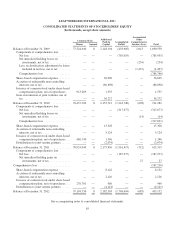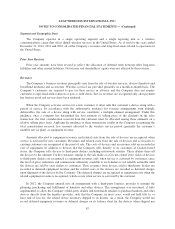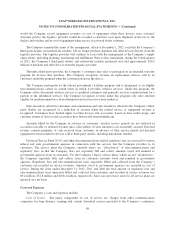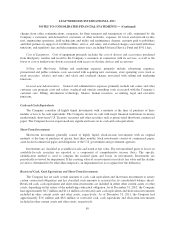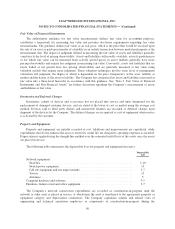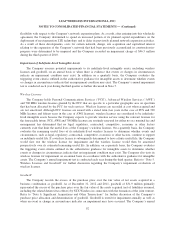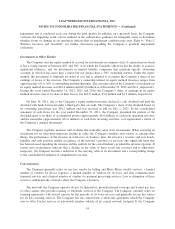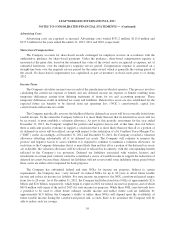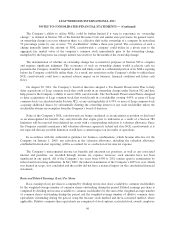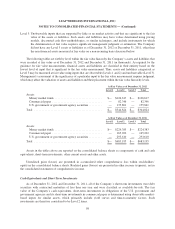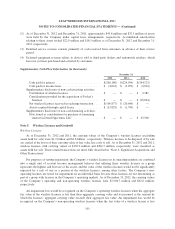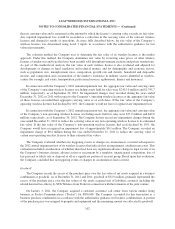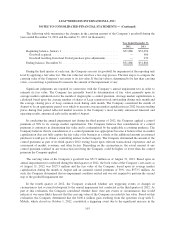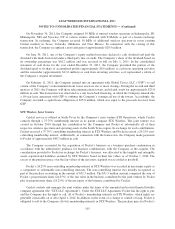Cricket Wireless 2012 Annual Report Download - page 109
Download and view the complete annual report
Please find page 109 of the 2012 Cricket Wireless annual report below. You can navigate through the pages in the report by either clicking on the pages listed below, or by using the keyword search tool below to find specific information within the annual report.LEAP WIRELESS INTERNATIONAL, INC.
NOTES TO CONSOLIDATED FINANCIAL STATEMENTS — (Continued)
Advertising Costs
Advertising costs are expensed as incurred. Advertising costs totaled $131.2 million, $115.8 million and
$137.6 million for the years ended December 31, 2012, 2011 and 2010, respectively.
Share-based Compensation
The Company accounts for share-based awards exchanged for employee services in accordance with the
authoritative guidance for share-based payments. Under the guidance, share-based compensation expense is
measured at the grant date, based on the estimated fair value of the award, and is recognized as expense, net of
estimated forfeitures, over the employee’s requisite service period. Compensation expense is amortized on a
straight-line basis over the requisite service period for the entire award, which is generally the vesting period of
the award. No share-based compensation was capitalized as part of inventory or fixed assets prior to or during
2012.
Income Taxes
The Company calculates income taxes in each of the jurisdictions in which it operates. This process involves
calculating the current tax expense or benefit and any deferred income tax expense or benefit resulting from
temporary differences arising from differing treatments of items for tax and accounting purposes. These
temporary differences result in deferred tax assets and liabilities. Deferred tax assets are also established for the
expected future tax benefits to be derived from net operating loss (“NOL”) carryforwards, capital loss
carryforwards and income tax credits.
The Company periodically assesses the likelihood that its deferred tax assets will be recoverable from future
taxable income. To the extent the Company believes it is more likely than not that its deferred tax assets will not
be recovered, it must establish a valuation allowance. As part of this periodic assessment for the year ended
December 31, 2012, the Company weighed the positive and negative factors and, at this time, does not believe
there is sufficient positive evidence to support a conclusion that it is more likely than not that all or a portion of
its deferred tax assets will be realized, except with respect to the realization of a $1.9 million Texas Margins Tax
(“TMT”) credit. Accordingly, at December 31, 2012 and December 31, 2011, the Company recorded a valuation
allowance offsetting substantially all of its deferred tax assets. The Company will continue to monitor the
positive and negative factors to assess whether it is required to continue to maintain a valuation allowance. At
such time as the Company determines that it is more likely than not that all or a portion of the deferred tax assets
are realizable, the valuation allowance will be reduced or released in its entirety, with the corresponding benefit
reflected in the Company’s tax provision. Deferred tax liabilities associated with wireless licenses and
investments in certain joint ventures cannot be considered a source of taxable income to support the realization of
deferred tax assets because these deferred tax liabilities will not reverse until some indefinite future period when
these assets are either sold or impaired for book purposes.
The Company has substantial federal and state NOLs for income tax purposes. Subject to certain
requirements, the Company may “carry forward” its federal NOLs for up to 20 years to offset future taxable
income and reduce its income tax liability. For state income tax purposes, the NOL carryforward period ranges
from five to 20 years. As of December 31, 2012, the Company had federal and state NOLs of approximately $2.6
billion and $2.0 billion, respectively, which begin to expire in 2022 for federal income tax purposes and of which
$69.8 million will expire at the end of 2013 for state income tax purposes. While these NOL carryforwards have
a potential to be used to offset future ordinary taxable income and reduce future cash tax liabilities by
approximately $1.0 billion, the Company’s ability to utilize these NOLs will depend upon the availability of
future taxable income during the carryforward period and, as such, there is no assurance the Company will be
able to realize such tax savings.
95


